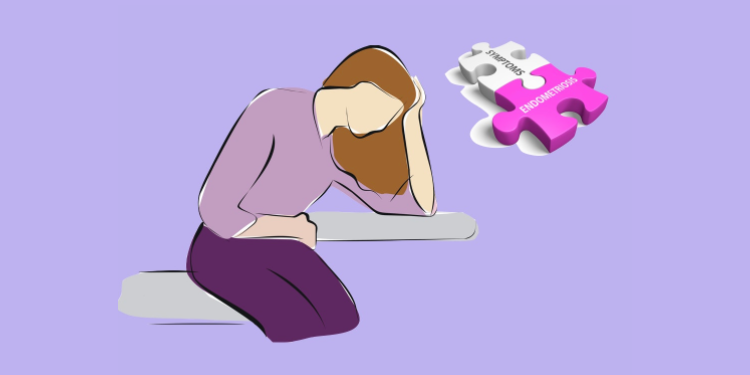Last week, I talked about how fainting from period pain led to my diagnosis of endometriosis. This week, I’m putting on my doctor hat to talk about what endometriosis is, how to find out if you have it, and what to do about it. Of course, I was still a student at the time I was diagnosed; I have since qualified as a medical doctor. With my medical background and my personal experience, I’ll make this as simple and relatable as possible. From biology class, you probably remember that the main organ of reproduction in females is the uterus. What we commonly call the womb. The endometrium, a special tissue, lines the womb. The endometrium (tissue) breaks down monthly and comes out as the menstrual flow.
Endometriosis, however, occurs when these endometrial cells are in places outside the womb. The places most commonly affected are the ovaries, fallopian tubes, and other organs of the pelvis. Rarely, the endometrial tissue may spread beyond the pelvic organs and affect organs in the abdomen. The displaced endometrial tissue continues to act as it normally would in the womb. It thickens, breaks down and bleeds with each menstrual cycle. Of course, because it is in the wrong place and has no way to exit the body, it becomes trapped. This whole process is why women who have endometriosis have more painful periods than the average woman.
Unfortunately, no one knows the cause of endometriosis and as such there is no way to prevent getting it. Another problem is that endometriosis can be difficult to diagnose. I talked about how doctors thought mine was appendicitis at some point. That was to the extent that I had to go through surgery. Ideally, any experienced doctor should consider the possibility of endometriosis when a woman presents certain symptoms. However, doctors sometimes mistaken endometriosis for other conditions that can cause pain in the lower abdomen. Such include pelvic inflammatory disease (PID) or ovarian cysts.
How To Get A Diagnosis
The only way to confirm a diagnosis of endometriosis is by carrying out a laparoscopy. A laparoscopy is not a typical “big surgery” during which the body is cut in a significant way. For a laparoscopy, small cuts are made on the belly. Through that, a small camera is passed to look inside the body for evidence of endometriosis. When this is done in women who have endometriosis, the displaced tissue can usually be seen dotting the pelvic organs. Trapped blood makes up these cysts–“chocolate cysts” because of their dark coloured appearance. The good thing about getting a laparoscopy is that it can confirm the problem and it can also be used to treat it.
Some of the symptoms usually associated with endometriosis include:
- Painful Periods: The most common complaint of endometriosis is painful periods. Like I described in my previous post, I used to dread my periods because they came with excruciating pain. Not just the regular belly cramps but also lower back pain. The pain that was far worse than the normal menstrual pain that other girls around me experienced. And this pain sometimes grows worse over the years in some women. One of the complications of endometriosis is the formation of scar tissues called adhesions. They form as a result of constant irritation of the surrounding tissues around the endometrial deposits. This can also cause the pain to become worse over time.
- Painful Sexual Intercourse: Some women also experience pain during and after sexual intercourse.
- Painful Excretion: There may also be pain when passing stool or urine, depending on the location of the endometrial tissue.
- Excessive Menstrual Bleeding: Women with endometriosis tend to have more endometrial tissue than the average woman, and sometimes this leads to excessive menstrual bleeding or bleeding between periods.
- Infertility: Getting pregnant can be difficult for women with endometriosis. Many women only get diagnosed with endometriosis when they seek medical help to get pregnant.
Note however, that endometriosis is not a hopeless condition. There are stories of women who surmounted the obstacles and went ahead to have children naturally. The important thing is finding an experienced gynecologist. S/he can perform the necessary surgery to confirm endometriosis and also start to treat it.
Treatment and Management
Apart from surgery, there are other options for treatment, including the injection I mentioned I had to take after my surgery. This injection is a hormone and it is given on a monthly basis and helps prevent formation of more endometrial deposits. For women whose main concern is a heavy period, there is a contraceptive that can be inserted into the uterus which reduces the heavy flow. For women with concerns about fertility, assisted reproductive techniques such an IVF (in vitro fertilization) have been shown to help.
So, like I said, endometriosis is not a hopeless condition. If you suspect you or anyone you know has any of these symptoms, start by paying a visit to a gynecologist. Hopefully, you will get the help you need. Also, if you have a personal story of endometriosis and coping with the symptoms, please feel free to share them via the comment. Not only do I want to hear from you, your comment might help another woman.
